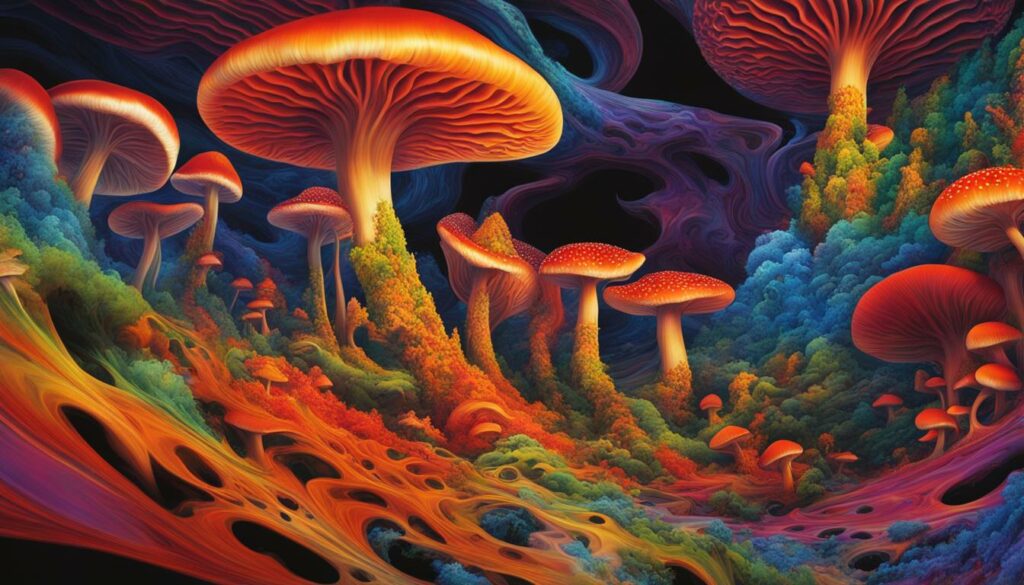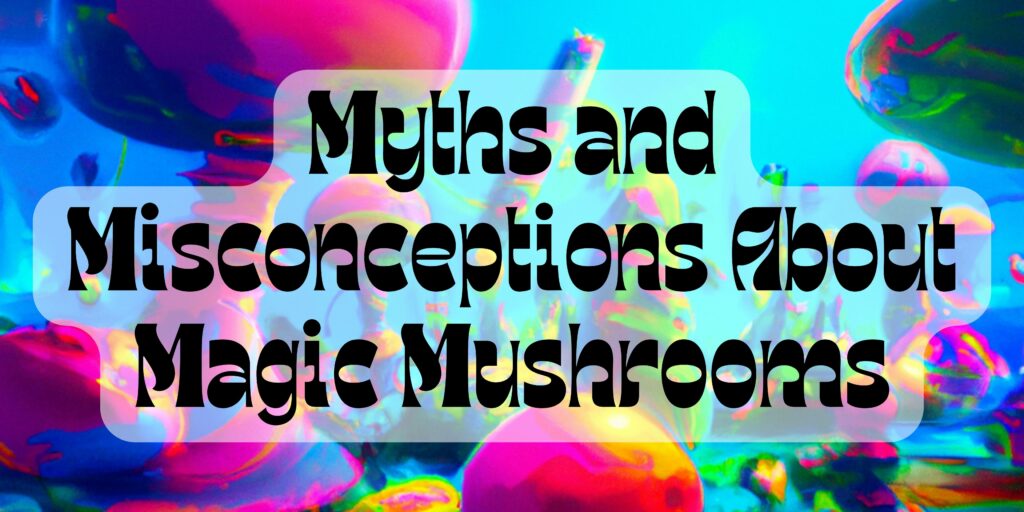Welcome to our comprehensive guide on understanding the long-term effects of shrooms. In this article, we will delve into the physical and psychological consequences of using psychedelic mushrooms over an extended period. From cognitive changes to emotional well-being, we will explore the potential effects and therapeutic benefits of these hallucinogens.
Key Takeaways:
- Long-term use of shrooms can lead to alterations in brain chemistry and potential psychological side-effects.
- Physical effects of shroom use include dilated pupils, elevated blood pressure, and increased heart rate.
- Shrooms have been explored for their therapeutic benefits in treating mental health disorders.
- It is important to consider the risks and practice harm reduction strategies when using shrooms.
- Seeking therapy and support can be beneficial in managing the potential long-term effects of shroom use.
What Are Shrooms and How Do They Work?
Shrooms, also known as magic mushrooms, are a group of fungi that contain the psychedelic compound psilocybin. When ingested, psilocybin is converted into psilocin in the body, which then interacts with serotonin receptors in the brain. This interaction leads to various effects, including hallucinations, altered perception, and changes in consciousness.
The hallucinogenic properties of shrooms can cause individuals to experience vivid visual and auditory hallucinations. These hallucinations often involve seeing patterns, colors, and objects that are not actually present. The altered perception caused by shrooms can also result in a distorted sense of time and space.
Moreover, shrooms can induce changes in consciousness, allowing users to experience a sense of expanded awareness and a greater connection to their surroundings. This can lead to profound spiritual experiences and insights into one’s own thoughts and emotions.
Table: Comparison of Shrooms and Other Psychedelic Compounds
| Psychedelic Compound | Main Source | Main Effects |
|---|---|---|
| Psilocybin (shrooms) | Magic mushrooms | Hallucinations, altered perception, changes in consciousness |
| LSD | LSD-25, a synthetic compound | Intense visual hallucinations, altered sense of self, spiritual experiences |
| DMT | Natural compound found in certain plants | Breakthrough visions, out-of-body experiences, connection to higher realms |
It’s important to note that the effects of shrooms can vary greatly depending on the individual, the dosage, and the setting in which they are consumed. While some users may have positive and transformative experiences, others may experience anxiety, confusion, or feelings of being overwhelmed. Understanding the psychedelic effects of shrooms is essential for making informed decisions about their use.
Short-Term Effects of Shrooms
When consuming shrooms, users can expect to experience various short-term effects. These effects are often characterized by a combination of physical, cognitive, and sensory experiences. Let’s dive into some of the most common short-term effects:
- Euphoria: Shrooms can induce intense feelings of happiness, joy, and overall well-being.
- Visual Hallucinations: One of the most well-known effects of shrooms is the presence of vivid and colorful visual hallucinations, often referred to as “trips”. These hallucinations can include morphing patterns, vibrant colors, and geometric shapes.
- Auditory Hallucinations: Users may also experience auditory hallucinations, such as hearing sounds or voices that are not actually present. These hallucinations can range from subtle distortions to more pronounced and transformative auditory experiences.
- Altered Sense of Time: Shrooms can distort one’s perception of time, making minutes feel like hours or hours feel like minutes. This altered sense of time can contribute to the overall surreal experience.
- Spiritual Experiences: Many users report having profound spiritual experiences while under the influence of shrooms. These experiences can include a sense of connection to a higher power, enhanced awareness of one’s place in the universe, and a deeper understanding of existential questions.
It is important to note that the intensity and duration of these effects can vary depending on factors such as the dosage, individual tolerance, set and setting, and the user’s mental state prior to consumption. Additionally, the effects of shrooms can be unpredictable and may differ from person to person.
| Short-Term Effects of Shrooms | Common Experiences |
|---|---|
| Euphoria | Intense feelings of happiness and joy |
| Visual Hallucinations | Vivid and colorful visual distortions and patterns |
| Auditory Hallucinations | Hearing sounds or voices that are not present |
| Altered Sense of Time | Distorted perception of time |
| Spiritual Experiences | Profound sense of connection and awareness |
It is crucial to approach shroom use with caution and in a safe environment, especially considering the potential for intense psychological effects. Individuals should be well-informed, practice harm reduction strategies, and consider the potential risks and benefits before engaging in shroom consumption.

Risks and Precautions
While shrooms can offer unique experiences, it is essential to be mindful of the potential risks associated with their use. Some individuals may experience negative reactions or “bad trips,” characterized by feelings of anxiety, fear, and confusion. These episodes can be distressing and overwhelming, highlighting the importance of having a trusted support system and a calm environment.
In addition to psychological risks, it is also crucial to be aware of the physical risks that may arise from shroom consumption. It is recommended to avoid consuming shrooms if you have a history of certain medical conditions, such as cardiovascular issues, as they can potentially exacerbate these conditions.
Ultimately, proper education, responsible use, and understanding personal limits are key to minimizing risks and ensuring a safe and enjoyable shroom experience.
Potential Psychological Side-Effects of Long-Term Shroom Use
Long-term shroom use can have significant psychological side-effects due to the alterations in brain chemistry that can occur. One potential side-effect is the development of Hallucinogen Persisting Perception Disorder (HPPD), which is characterized by recurring visual disturbances even after the use of shrooms has ceased. These disturbances may include trailing visual images or seeing colors more vividly. It is important to note that HPPD is rare, but individuals with a predisposition to mental health conditions may be more susceptible.
Another potential psychological side-effect of long-term shroom use is the occurrence of flashbacks. These are typically brief episodes where the individual experiences the hallucinatory effects of shrooms without having taken the drug. Flashbacks can be triggered by stress, anxiety, or other factors and may be distressing for the individual. Increased anxiety and depression are also common psychological side-effects of long-term shroom use. The altered brain chemistry can contribute to feelings of unease, worry, and sadness.
In some cases, long-term shroom use can lead to psychosis, which is a severe mental disorder characterized by a loss of touch with reality. Individuals experiencing psychosis may have delusions, hallucinations, disorganized thinking, and changes in behavior. It is important to recognize that not everyone who uses shrooms will develop psychosis, but individuals with a family history of mental illness or those predisposed to psychiatric conditions may be at a higher risk.
Changes in personality and behavior are also potential side-effects of long-term shroom use. Some individuals may experience shifts in their personality traits, such as becoming more introverted or having altered social behaviors. These changes can impact relationships and overall functioning. Additionally, addiction tendencies can develop in individuals who use shrooms regularly and rely on them for emotional regulation or escape.
| Psychological Side-Effects | Description |
|---|---|
| Hallucinogen Persisting Perception Disorder (HPPD) | Characterized by recurring visual disturbances even after shroom use has ceased |
| Flashbacks | Brief episodes of hallucinatory effects without taking the drug |
| Increased anxiety and depression | Common psychological side-effects due to altered brain chemistry |
| Psychosis | Severe mental disorder with loss of touch with reality |
| Changes in personality and behavior | Shifts in traits and altered social behaviors |
| Addiction tendencies | Develops in regular users relying on shrooms for emotional regulation or escape |
Physical Effects and Risks of Shroom Use
While shrooms may elicit profound psychological experiences, it’s essential to understand the physical effects and risks associated with their use. When consumed, psilocybin mushrooms can cause several physiological changes in the body.
Some of the most common physical effects include dilated pupils, elevated blood pressure, increased heart rate, nausea, increased perspiration, tremors, anxiety, panic attacks, and paranoia. These symptoms may vary in intensity depending on factors such as dosage, individual tolerance, and set and setting.
The toxicological impact of psilocybin mushrooms is relatively low compared to many other substances. Lethal doses are extremely rare, and severe physical harm from shroom use is uncommon. However, it is crucial to note that individuals with pre-existing medical conditions, particularly cardiovascular problems, should exercise caution when using shrooms due to the potential strain on the cardiovascular system.
| Physical Effects | Risks |
|---|---|
|
|
It is important to approach shroom use responsibly and be mindful of both the physical and psychological effects. If you have any concerns about your health or are unsure if shrooms are suitable for you, it is advisable to consult with a healthcare professional.
Despite these physical effects and risks, it’s crucial to remember that shrooms are one of the least toxic drugs known. Being aware of the potential physical effects can help individuals make informed decisions about their psychedelic experiences and prioritize harm reduction strategies.

Understanding the physical effects and risks associated with shroom use provides a foundation for safer and more responsible psychedelic experiences. By being informed and practicing harm reduction strategies, individuals can mitigate potential negative outcomes and optimize their overall well-being.
Cross-Tolerance and Long-Term Physical Effects
Long-term use of shrooms can result in a phenomenon known as cross-tolerance, where the body develops a tolerance not only to psilocybin but also to other hallucinogens. This means that individuals who regularly use shrooms may find that they need higher doses to achieve the same effects. Cross-tolerance can also extend to other substances with similar mechanisms of action, such as LSD or mescaline.
It is important to note that the physical effects of shrooms can vary depending on the individual and their underlying health conditions. For instance, individuals with cardiovascular issues may be at a higher risk of experiencing adverse physical effects, such as elevated blood pressure or heart rate. Additionally, impairments in judgment and coordination can increase the risk of accidents and injuries while under the influence of shrooms.
While there have been concerns about the long-term physical effects of shroom use, studies have shown that these effects are relatively rare. However, it is crucial for individuals to be aware of their own health and any chronic conditions they may have before using shrooms. If you have any concerns or questions, it is always best to consult with a healthcare professional.
| Physical Effects | Tolerance to Hallucinogens | Underlying Health Conditions | Judgment Impairments | Chronic Health Conditions |
|---|---|---|---|---|
| Dilated pupils | Cross-tolerance to other hallucinogens | Increased risk for individuals with cardiovascular issues | Impaired judgment and coordination | Potential interactions with chronic health conditions |
| Elevated blood pressure | Increased tolerance to psilocybin | |||
| Increased heart rate | Tolerance to LSD and mescaline | |||
| Nausea | ||||
| Increased perspiration | ||||
| Tremors | ||||
| Anxiety | ||||
| Panic attacks |
Potential Therapeutic Benefits and Psychological Impact
Shrooms have gained attention for their potential therapeutic benefits, particularly in the treatment of mental health disorders. Research suggests that psilocybin, the active compound in shrooms, may have positive effects on emotional well-being and psychological functioning.
One potential therapeutic benefit of shrooms is the potential for personality changes. Studies have shown that individuals who have undergone psilocybin-assisted therapy have reported increased openness, emotional stability, and a greater sense of well-being. These changes in personality can lead to improved relationships, increased resilience, and enhanced overall quality of life.
Creativity is another area where shrooms may have a positive impact. Many individuals report experiencing enhanced creativity and a heightened sense of imagination during and after psychedelic experiences. This can be particularly beneficial for artists, writers, and anyone seeking inspiration or new perspectives.
The potential for spirituality is also worth noting.
Shrooms have historically been used in religious and spiritual ceremonies due to their ability to induce mystical experiences. Some individuals report profound spiritual insights, a deeper connection to the universe, and a greater sense of purpose and meaning in life. These experiences can have long-lasting effects on one’s spiritual beliefs and practices.
It is important to note that while shrooms can have potential therapeutic benefits, they are not a cure-all for mental health disorders. The effects of psychedelic substances can vary greatly depending on the individual, set, and setting. It is essential to approach their use with caution and under the guidance of trained professionals.
| Therapeutic Benefits | Psychological Impact |
|---|---|
| Reduction in symptoms of depression, anxiety, and PTSD | Increased emotional well-being and resilience |
| Improved quality of life and overall psychological functioning | Enhanced creativity and imagination |
| Increased openness and emotional stability | Deepened sense of spirituality and connectedness |
While shrooms show promise in certain therapeutic applications, more research is needed to fully understand their potential benefits and risks. It is important to approach their use responsibly and with informed consent, focusing on harm reduction and ensuring a safe and supportive environment for psychedelic experiences.
Conclusion
As you consider the long-term effects of shrooms, it is essential to understand the physical and psychological consequences that may arise from their use. While shrooms can offer potential therapeutic benefits and unique experiences, it is important to be aware of the risks involved.
When it comes to making informed decisions, taking into account the risk factors is crucial. Factors such as underlying health conditions and individual susceptibility can influence how shrooms may affect you over time. By understanding these factors, you can better assess the potential impact on your well-being.
To minimize harm and ensure a positive experience, it is important to adopt harm reduction strategies. Educating yourself about proper dosage, creating a safe and comfortable environment, and seeking support if necessary are recommended practices. These steps can help reduce the potential risks associated with long-term shroom use.
Ultimately, making informed decisions about shroom use requires careful consideration of the potential long-term effects. By understanding the physical and psychological consequences, being aware of risk factors, and applying harm reduction strategies, you can approach the use of shrooms with a greater sense of responsibility and well-being.
FAQ
What are the long-term effects of using shrooms?
Long-term shroom use can lead to potential alterations in brain chemistry, the development of Hallucinogen Persisting Perception Disorder (HPPD), increased anxiety, depression, psychosis, changes in personality and behavior, and addiction tendencies.
What are the physical effects of shroom use?
The physical effects of shroom use include dilated pupils, elevated blood pressure, increased heart rate, nausea, increased perspiration, and tremors. These symptoms can sometimes amplify psychological effects such as anxiety, panic attacks, and paranoia.
Can shroom use have long-lasting physical effects?
Shroom use can lead to cross-tolerance, which can result in a high tolerance to related substances. While physical effects such as impaired judgment and coordination and increased risk of accidents and injuries can occur, long-term physical effects directly attributed to psilocybin mushrooms are rare.
Are shrooms being studied for therapeutic benefits?
Yes, shrooms have been explored for their potential therapeutic benefits, particularly in the treatment of mental health disorders. However, it is important to consider the potential impact on emotional well-being and mental health, as individuals may experience both positive and negative effects.
How can I minimize harm when using shrooms?
To minimize harm, it is recommended to educate oneself about proper dosage, create a safe and comfortable environment for psychedelic experiences, and seek support if necessary.




